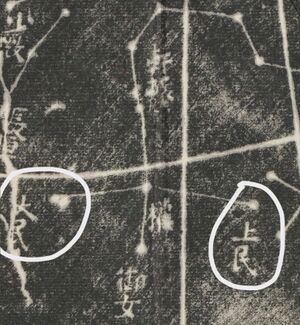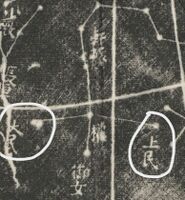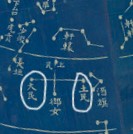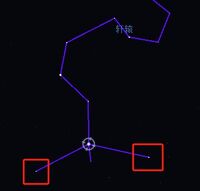Taimin and Shaomin: Difference between revisions
Boshunyang (talk | contribs) |
|||
| (12 intermediate revisions by 3 users not shown) | |||
| Line 3: | Line 3: | ||
{{DISPLAYTITLE:Taimin & Shaomin (太民、少民)}} |
{{DISPLAYTITLE:Taimin & Shaomin (太民、少民)}} |
||
== Etymology & History of the term == |
== Etymology & History of the term == |
||
The shape of Xuanyuan resembles a Chinese dragon, and these two stars are considered the left and right horns of the dragon. The specific meanings of Taimin and Shaomin are difficult to determine. However, according to the Western Han dynasty's ''Shi School Star Canon''(石氏星经), they were referred to as Taiming太明 (or Daming大明, both means "more bright") and Shaoming少明(means "less bright").<ref>Qutan Xida. Kaiyuanzhanjing 开元占经. Beijing: Jiuzhou Press, 2012:643-644.</ref> Literally, Taiming should be brighter than Shaoming, which is indeed the case: |
The shape of [[Xuanyuan]] resembles a Chinese dragon, and these two stars are considered the left and right horns of the dragon. The specific meanings of Taimin and Shaomin are difficult to determine. However, according to the Western Han dynasty's ''Shi School Star Canon''(石氏星经), they were referred to as Taiming太明 (or Daming大明, both means "more bright") and Shaoming少明(means "less bright").<ref>Qutan Xida. Kaiyuanzhanjing 开元占经. Beijing: Jiuzhou Press, 2012:643-644.</ref> Literally, Taiming should be brighter than Shaoming, which is indeed the case: |
||
* Taiming is omicron Leonis (o Leo) with a magnitude of 3.5, while |
* Taiming is omicron Leonis (o Leo) with a magnitude of 3.5, while |
||
| Line 12: | Line 12: | ||
According to ancient Chinese star divination theory, Xuanyuan represents the group of empresses and consorts. Under this context, these two stars were given specific meanings: Taimin represented the clan of the Empress Dowager, while Shaomin represented the clan of the Empress. This interpretation was established during the Han dynasty. |
According to ancient Chinese star divination theory, Xuanyuan represents the group of empresses and consorts. Under this context, these two stars were given specific meanings: Taimin represented the clan of the Empress Dowager, while Shaomin represented the clan of the Empress. This interpretation was established during the Han dynasty. |
||
=== Spelling Variants === |
|||
The Suzhou chart mistakenly recorded Shaomin as Shangmin上民, which was further erroneously written as Tumin土民 in the Qing dynasty star map. |
|||
* Taiming = Taimin = Daming = Damin |
|||
* Shaoming = Shaomin = Tumin = Shangmin |
|||
=== Identifications === |
|||
{| class="wikitable" |
|||
|+ |
|||
!Star Names or Orders(Traditional/Qing) |
|||
!Ho PENG YOKE<ref>P.-Y. Ho, “Ancient And Mediaeval Observations of Comets and Novae in Chinese Sources,” ''Vistas in Astronomy'', 5(1962), 127-225.</ref> |
|||
!Yi Shitong<ref>Yi Shitong伊世同. ''Zhongxi Duizhao Hengxing Tubiao''中西对照恒星图表1950. Beijing: Science Press.1981: 56.</ref> |
|||
Based on catalogue in 18th century |
|||
!Pan Nai<ref name=":0">Pan Nai潘鼐. ''Zhongguo Hengxing Guance shi''中国恒星观测史[M]. Shanghai: Xuelin Pree. 1989. p226.</ref> |
|||
based on Xinyixiangfayao Star Map |
|||
!Pan Nai<ref>Pan Nai潘鼐. ''Zhongguo Hengxing Guance shi''中国恒星观测史[M]. Shanghai: Xuelin Pree. 2009. p443.</ref> |
|||
based on catalogues in Yuan dynasty |
|||
!SUN X. & J. Kistemaker<ref>Sun Xiaochun. & Kistemaker J. ''The Chinese sky during the Han''. Leiden: Brill. 1997, Pp241-6.</ref> |
|||
Han Dynasty |
|||
!Boshun Yang<ref name=":1">B.-S. Yang杨伯顺, ''Zhongguo Chuantong Hengxing Guance Jingdu ji Xingguan Yanbian Yanjiu'' 中国传统恒星观测精度及星官演变研究 (A Research on the Accuracy of Chinese Traditional Star Observation and the Evolution of Constellations), PhD thesis, (Hefei: University of Science and Technology of China, 2023). 261.</ref> |
|||
before Tang dynasty |
|||
!Boshun Yang<ref name=":1" /> |
|||
Song Jingyou(1034) |
|||
|- |
|||
|Taimin |
|||
|o Leo |
|||
|o Leo |
|||
|o Leo |
|||
|o Leo |
|||
|o Leo |
|||
|o Leo |
|||
|o Leo |
|||
|- |
|||
|Shaomin |
|||
|ρ Leo |
|||
|ρ Leo |
|||
|ρ Leo |
|||
|ρ Leo |
|||
|ρ Leo |
|||
| ρ Leo |
|||
|ρ Leo |
|||
|} |
|||
== Images and Transformation == |
== Images and Transformation == |
||
From the perspective of Xuanyuan the dragon itself, omi Leo as the left horn (Taimin) and rho Leo as the right horn (Shaomin) is very natural. However, from the viewpoint of an observer within the celestial sphere, Shaomin is actually on the left (east) and Taimin on the right (west). This may be the reason why the positions of Taimin and Shaomin were later swapped, as shown in the Suzhou astronomical chart. |
From the perspective of Xuanyuan the dragon itself, omi Leo as the left horn (Taimin) and rho Leo as the right horn (Shaomin) is very natural. However, from the viewpoint of an observer within the celestial sphere, Shaomin is actually on the left (east) and Taimin on the right (west). This may be the reason why the positions of Taimin and Shaomin were later swapped, as shown in the Suzhou astronomical chart. <gallery widths="200" heights="200" perrow="3" caption="Taimin and Shaomin"> |
||
File:Taimin and Shaomin on Suzhou star map.jpg|Taimin and Shaomin on Suzhou star map |
File:Taimin and Shaomin on Suzhou star map.jpg|Taimin and Shaomin on Suzhou star map (1247) |
||
File:Taimin and Shaomin on Qing star map.jpg|Taimin and Shaomin on Qing star map |
File:Taimin and Shaomin on Qing star map.jpg|Taimin and Shaomin on Qing star map |
||
File:Taimin & Shaomin.jpeg|Taimin & Shaomin in Stellarium |
|||
</gallery> |
</gallery> |
||
== IAU WGSN Name discussion == |
== IAU WGSN Name discussion == |
||
In 2024, the two names were brought to the attention of the IAU WG. omicron Leonis already is in the IAU-Catalog of Star Names, registered with the name Subra but rho Leonis doesn't have a name yet. Hence, we suggest to name it Shaomin(g). [https://simbad.cds.unistra.fr/simbad/sim-id?Ident=rho+Leo&NbIdent=1&Radius=2&Radius.unit=arcmin&submit=submit+id rho Leo (SIMBAD)] is a blue supergiant with a visual magnitude of 3.87 mag. |
In 2024, the two names were brought to the attention of the IAU WG. omicron Leonis already is in the IAU-Catalog of Star Names, registered with the name Subra but rho Leonis doesn't have a name yet. Hence, we suggest to name it Shaomin(g). [https://simbad.cds.unistra.fr/simbad/sim-id?Ident=rho+Leo&NbIdent=1&Radius=2&Radius.unit=arcmin&submit=submit+id rho Leo (SIMBAD)] is a very interesting B blue supergiant with a visual magnitude of 3.87 mag. It appears that there are no proper names for rho Leo in SIMBAD. |
||
We are (yet) unaware of any other cultural names for this star - which is somewhat surprising given its brightness and location in the ecliptic. This is a remarkably massive, luminous, [http://stars.astro.illinois.edu/sow/rholeo.html young star situated well out of the Galactic plane]. |
|||
==References == |
==References == |
||
| Line 30: | Line 75: | ||
[[Category:East Asian]] |
[[Category:East Asian]] |
||
[[Category:Chinese ]] |
[[Category:Chinese ]] |
||
[[Category:Leo]] |
|||
Latest revision as of 07:33, 6 March 2025
Taimin太民 (or Damin大民) for o Leo and Shaomin少民 (ρ Leo) are the two southernmost stars of the Xuanyuan轩辕 constellation. They used to star names in ancient China.
Etymology & History of the term
The shape of Xuanyuan (轩辕) resembles a Chinese dragon, and these two stars are considered the left and right horns of the dragon. The specific meanings of Taimin and Shaomin are difficult to determine. However, according to the Western Han dynasty's Shi School Star Canon(石氏星经), they were referred to as Taiming太明 (or Daming大明, both means "more bright") and Shaoming少明(means "less bright").[1] Literally, Taiming should be brighter than Shaoming, which is indeed the case:
- Taiming is omicron Leonis (o Leo) with a magnitude of 3.5, while
- Shaoming is rho Leonis (ρ Leo) with a magnitude of 3.8.
It is noteworthy that "Ming" and "Min" sound very similar, leading to the possible evolution of "Taiming" and "Shaoming" into "Taimin" and "Shaomin" over time.
According to ancient Chinese star divination theory, Xuanyuan represents the group of empresses and consorts. Under this context, these two stars were given specific meanings: Taimin represented the clan of the Empress Dowager, while Shaomin represented the clan of the Empress. This interpretation was established during the Han dynasty.
Spelling Variants
The Suzhou chart mistakenly recorded Shaomin as Shangmin上民, which was further erroneously written as Tumin土民 in the Qing dynasty star map.
- Taiming = Taimin = Daming = Damin
- Shaoming = Shaomin = Tumin = Shangmin
Identifications
| Star Names or Orders(Traditional/Qing) | Ho PENG YOKE[2] | Yi Shitong[3]
Based on catalogue in 18th century |
Pan Nai[4]
based on Xinyixiangfayao Star Map |
Pan Nai[5]
based on catalogues in Yuan dynasty |
SUN X. & J. Kistemaker[6]
Han Dynasty |
Boshun Yang[7]
before Tang dynasty |
Boshun Yang[7]
Song Jingyou(1034) |
|---|---|---|---|---|---|---|---|
| Taimin | o Leo | o Leo | o Leo | o Leo | o Leo | o Leo | o Leo |
| Shaomin | ρ Leo | ρ Leo | ρ Leo | ρ Leo | ρ Leo | ρ Leo | ρ Leo |
Images and Transformation
From the perspective of Xuanyuan the dragon itself, omi Leo as the left horn (Taimin) and rho Leo as the right horn (Shaomin) is very natural. However, from the viewpoint of an observer within the celestial sphere, Shaomin is actually on the left (east) and Taimin on the right (west). This may be the reason why the positions of Taimin and Shaomin were later swapped, as shown in the Suzhou astronomical chart.
- Taimin and Shaomin
IAU WGSN Name discussion
In 2024, the two names were brought to the attention of the IAU WG. omicron Leonis already is in the IAU-Catalog of Star Names, registered with the name Subra but rho Leonis doesn't have a name yet. Hence, we suggest to name it Shaomin(g). rho Leo (SIMBAD) is a very interesting B blue supergiant with a visual magnitude of 3.87 mag. It appears that there are no proper names for rho Leo in SIMBAD.
We are (yet) unaware of any other cultural names for this star - which is somewhat surprising given its brightness and location in the ecliptic. This is a remarkably massive, luminous, young star situated well out of the Galactic plane.
References
- ↑ Qutan Xida. Kaiyuanzhanjing 开元占经. Beijing: Jiuzhou Press, 2012:643-644.
- ↑ P.-Y. Ho, “Ancient And Mediaeval Observations of Comets and Novae in Chinese Sources,” Vistas in Astronomy, 5(1962), 127-225.
- ↑ Yi Shitong伊世同. Zhongxi Duizhao Hengxing Tubiao中西对照恒星图表1950. Beijing: Science Press.1981: 56.
- ↑ Pan Nai潘鼐. Zhongguo Hengxing Guance shi中国恒星观测史[M]. Shanghai: Xuelin Pree. 1989. p226.
- ↑ Pan Nai潘鼐. Zhongguo Hengxing Guance shi中国恒星观测史[M]. Shanghai: Xuelin Pree. 2009. p443.
- ↑ Sun Xiaochun. & Kistemaker J. The Chinese sky during the Han. Leiden: Brill. 1997, Pp241-6.
- ↑ 7.0 7.1 B.-S. Yang杨伯顺, Zhongguo Chuantong Hengxing Guance Jingdu ji Xingguan Yanbian Yanjiu 中国传统恒星观测精度及星官演变研究 (A Research on the Accuracy of Chinese Traditional Star Observation and the Evolution of Constellations), PhD thesis, (Hefei: University of Science and Technology of China, 2023). 261.








